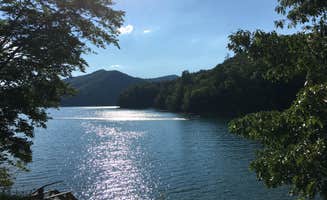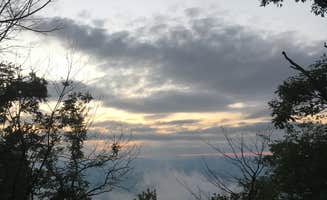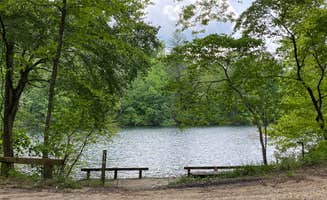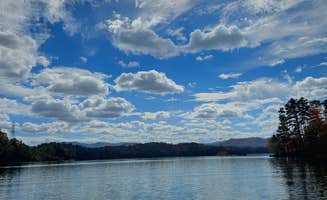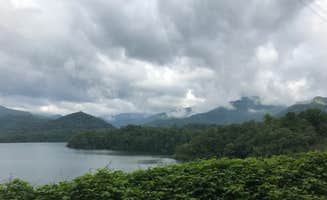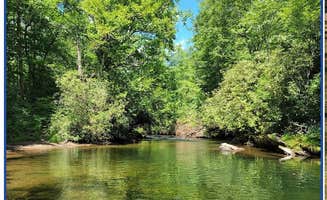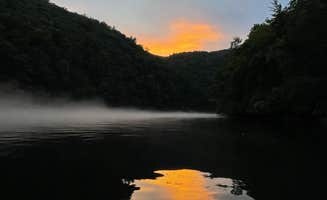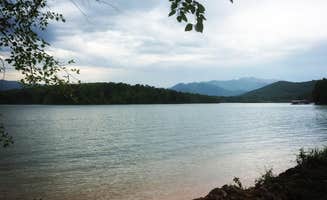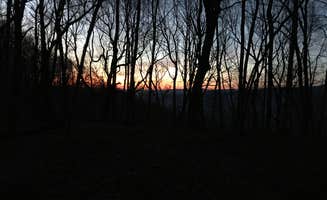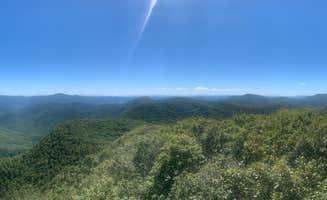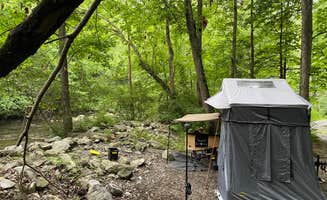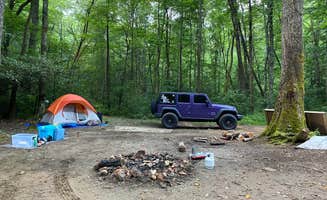The Nantahala National Forest surrounding Bear Creek, North Carolina sits at elevations between 1,200 and 5,800 feet in the southwestern corner of the state. This mountainous terrain creates distinct camping microclimates, with temperatures typically 10-15°F cooler than nearby cities. Dispersed camping options near Bear Creek offer basic backcountry experiences with varying accessibility depending on seasonal road conditions and rainfall amounts.
What to do
Fishing access points: Long Hungry Road Dispersed Campsites provides multiple lake fishing opportunities. According to one camper, "I could walk down to the bank to fish and have a fire," while another noted that you'll find "good fishing" with "bass and bluegills" at several sites.
Hiking trails: The area around Wesser Bald Fire Tower offers short but rewarding hikes. One visitor mentioned, "Started out after dark and set up hammocks under the fire tower. Nice hike and good view in the morning." For longer treks, the Bartram Trail runs through the region with multiple primitive camping options along its route.
Paddling opportunities: Several dispersed sites provide direct water access for non-motorized boats. At Lake Santeelah Dispersed, campers appreciate the "sites right along the lake with a beautiful view of the mountains in the distance" and how "clear the water was excellent for swimming."
Wildlife viewing: The forests around Bear Creek host diverse wildlife. Bring binoculars to spot birds like the Tufted Titmouse. One camper at Lake Santeetlah noted, "We had lots of birds and butterflies around camp."
What campers like
Solitude and spacing: Sites throughout the area provide ample separation between campers. At Long Hungry Road Dispersed Campsites, one reviewer observed the sites are "mainly flat for tent camping" while another appreciated that "spots are very well laid out and maintained."
Established amenities: Despite being primitive, many sites include basic facilities. A camper noted, "This is the most established dispersed campsite that I've stayed at as it has a fire circle, a grill and a picnic table."
Water proximity: Several campsites offer direct lake access. One camper at Lake Santeetlah Dispersed described their experience: "Our site was a quarter mile peninsula that we had to ourselves. All the sites very in size, shape, and proximity to the road and lake."
Free camping: All dispersed sites in the Nantahala National Forest are free to use, with some requiring a bit more effort to reach. As one visitor put it, "If you are willing to bring everything with you, pack everything out, and paddle multiple miles on a nonmotorized finger lake, this is the place for you!"
What you should know
Site availability patterns: Competition for prime spots follows predictable patterns. A visitor to Fires Creek Hunters Camp described it as "a little loop drive across from a day use area on Fires Creek. Pick a spot, and set up your tent." Another camper warned about timing: "Showed up around 2:30-3 o'clock on a Sunday afternoon and most of the spots were already called for."
Navigation challenges: Road access varies significantly between sites. One camper advised: "The sign at the road looks like it was either taken down or blew away. The pin drop doesn't take you to the turn in on google or Apple Maps."
Limited facilities: Most sites lack basic amenities. A camper noted: "There is a concrete outhouse but no potable water. Huskins Branch runs through the middle of the area."
Cell service availability: Connectivity varies by location and carrier. At some sites "AT&T works just fine" while others report "no service with Verizon" at their particular campsite.
Tips for camping with families
Site selection considerations: Choose spots with flat terrain and water access for easier family camping. One family camper at Bartram Trail Campground found "a decently large site and has access to water if you climb down a small hill. On top of that it has a nice little firepit and flat ground for setting up your tent."
Safety patrol presence: Some areas have regular monitoring. A solo female camper noted, "Highway Patrol and Park Rangers patrol pretty frequently so I felt really safe as a solo female. I still took all the safety precautions but didn't feel as necessary as some."
Swimming options: Several sites offer kid-friendly water access. A camper described one location: "You are right in the little slickrock cover with waterfalls as white noise... if you take it about 1.5 miles you'll reach wolfcat falls which has a big swimming hole at the bottom."
Weather preparations: Mountain weather can change rapidly. Pack layers as temperatures at these elevations can drop 20-30°F from day to night, even in summer.
Tips from RVers
Best RV-accessible sites: Limited options exist for larger vehicles. One RVer at Calderwood Lake Primitive campground noted that "if you enjoy hiking campsite one is right on the slickrock trail" with easy access to activities.
Site dimensions and parking: Most dispersed sites accommodate smaller rigs only. A reviewer mentioned, "We were fortunate to get a site that allowed us to pull the car right into the site for our roof top tent," while another specified their site "was long and pretty flat."
Road condition warnings: Access roads require careful navigation. One RVer cautioned, "Warning: the road to get to Lake Santeetlah has endless sharp turns & drop-offs, would not recommend driving this in the dark."
Power solutions: With no hookups available, solar setups work well in open areas. Consider portable panels rather than roof-mounted systems since many sites are shaded.


